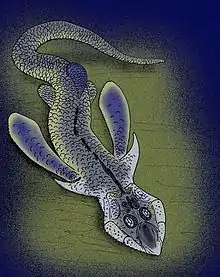Paraplesiobatis
Paraplesiobatis heinrichsi is a lightly armored pseudopetalichthyid placoderm from the Hunsrückschiefer Lagerstätte of Early Devonian Germany. The type and only known specimen is an articulated, but very incomplete individual consisting of a large, incomplete, plate-covered head, and some of the vertebral column, with a total length of 10 centimeters. The specimen strongly resembles Pseudopetalichthys to the point that many experts suggest they may be of the same genus or species,[1] though because the only specimens of both genera are so poorly preserved, talk of synonymizing the two can not begin (let alone continue) until more, better preserved specimens are found.[1]
| Paraplesiobatis Temporal range: Emsian | |
|---|---|
 | |
| Artist's reconstruction | |
| Scientific classification | |
| Kingdom: | |
| Phylum: | |
| Class: | |
| Order: | Denison 1975 |
| Family: | Paraplesiobatidae Berg 1940 |
| Genus: | Paraplesiobatis |
| Species: | P. heinrichsi |
| Binomial name | |
| Paraplesiobatis heinrichsi Broili, 1933 | |
References
- Denison, Robert (1978). Placodermi Volume 2 of Handbook of Paleoichthyology'. Stuttgart New York: Gustav Fischer Verlag. pp. 22–23. ISBN 978-0-89574-027-4.
This article is issued from Wikipedia. The text is licensed under Creative Commons - Attribution - Sharealike. Additional terms may apply for the media files.
